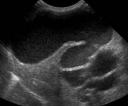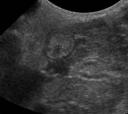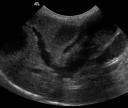Extrahepatic biliary obstruction is a reasonably common clinical scenario in older cats. Chronic cholangiohepatitis, pancreatitis and neoplasia can all cause bile duct obstruction with jaundice and high serum bilirubin. The bile duct can undergo a chronic partial obstruction from a mass or inflammatory tissue, or an acute obstruction from a calculus.
In complete biliary obstruction, the gallbladder is enlarged. The cystic duct and common bile duct become dilated and tortuous (image 1). The normal common bile duct should measure less than 4 mm in diameter. Trace it to the duodenal papilla to check for calculi and masses (image 2). The papilla should also be less than 4 mm. The one pictured here measured 3.6 mm.
Once the complete obstruction has been present for a week, the intrahepatic bile ducts also dilate. In image 3, the intrahepatic bile duct is the anechoic structure next to the gall bladder. When color Doppler is applied, there is no flow, though it is similar in size to portal and hepatic veins. The inner surface of the wall is also slightly irregular which may represent inflammatory tissue or calculus.
Nyland TG, Gillett NA. Sonographic evaluation of experimental bile duct ligation in the dog. Veterinary Radiology 1982;23:252-260.



Recent Comments